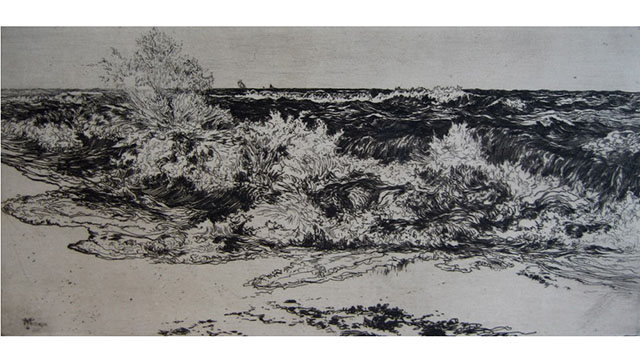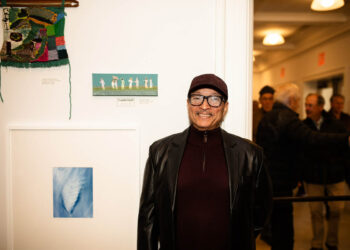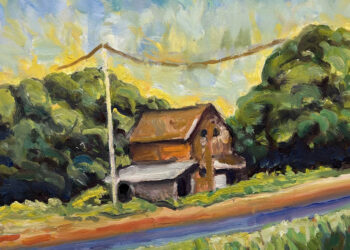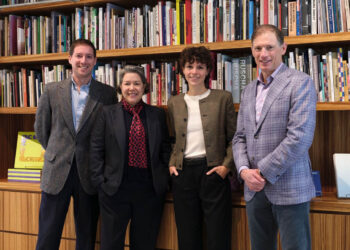After an extensive restoration, the Thomas & Mary Nimmo Moran Studio will officially open to the public this July. The East Hampton Historical Society, the new stewards of the Studio, is commemorating the milestone occasion with an Opening Celebration that will take place on Friday, July 6.
We caught up with Richard Barons, East Hampton Historical Society Senior Curator, to learn more about the turreted Queen Anne shingled Victorian structure, which is widely recognized as one of the initial stand-alone artist’s studios constructed on the East End.
When renovating the Studio, which is a National Historic Landmark, what were some of the biggest challenges the Society faced?
RB: It’s been a historical landmark since the 1970s so the biggest challenge probably was the deteriorated condition of the building. It had not really shall we say been taken care of. It also suffered during Hurricane Sandy. It got bumped, it sort of moved, which caused some of the sills to deteriorate and drop a couple of inches and cracked walls and damaged the ceilings. In other words, it was almost like an abandoned building, even though it had been lived in probably five or six years ago. But like many wooden structures, if they’re not taken care of diligently, it seems like all of the sudden they seem to crumble.
The Historical Society didn’t take over the Studio until several months ago. The Thomas Moran Trust, which still exists and is the agency that acquired the property from Guild Hall and then raised much of the original money for starting the restoration. The restoration aggressively started in 2013.
The restoration project took five years. What does it mean to the Society to finally be able to show it off to the public?
RB: It’s almost beyond comprehension. I think the most wonderful thing is often times we’ve had a fundraising party on the grounds and let people look in the building. There were times when we couldn’t even let people inside of it, so I think it’s been particularly entertaining to have those people, often time funders, come back.
 |
|
Mary Nimmo Moran’s etching titled Summer, East Hampton, created in 1883. (Photo: Courtesy of the East Hampton Historical Society) |
Could you talk a bit about the restoration efforts?
RB: The whole idea was to get it back to what the house looked like around 1900. It was built in 1884, but 1900 was chosen because in 1899 Thomas Moran’s artist wife, Mary Nimmo Moran, died. It seemed as though our job was really to celebrate both artists so it seemed logical, and it was even more logical as we began to understand how the building had been added onto and added onto and added onto. Little was done after 1900. I think the last major thing the Morans did, Thomas and his daughter Ruth, was add two bathrooms with running water in 1900. Our job was to get rid of some of the things that had been added on in the mid-20th century by the Lamb family, who had acquired it directly from Ruth Moran in the later 1940s, and was to try to figure out what had been done, stairways had been removed, lots of things had happened inside. It was our job to get it back to larger spaces that in reality were part of the original design and to try to preserve as much of the original as possible. In the beginning, that did not seem like it was going to be possible because there was so much dry rot and weather trauma. In the end, we were able to save so much more of the wainscoting and original windows and things of that nature. It looks pretty much now exactly what it looked like in the 1900s.
Could you please talk a bit about the Studio and the Moran’s impact on the East End community?
RB: It’s probably more important than at first glance because Moran is most famous in the world of art history for his enormous and loving and atmospheric paintings of the west and he probably was the first professional artist to visit the Grand Canyon. But, he also fell in love with the East End of Long Island in probably the late 1870s because his wife and he, by 1880, they were summering here in East Hampton. Some of the most beautiful etchings of the local locality by both of the artists are started just about 1880. A lot of them look at Town Pond. They were particularly enthralled with Hook Pond and Thomas was very excited by the beaches and the waves. By 1883 or so they began looking for a property and they acquired the property where the Studio is in 1884 and immediately started construction. I think they were staying at the time what is now Maidstone Hotel, but at the time was the Osborn House. So it was even an inn in the 1880s. So they were right next to it, watching it carefully and their role in the community is surprising strong.
Obviously there’s a them and us, there’s that in every summer colony, but there’s something about the Morans, probably because they usually spent about six months out here. They weren’t really so much summer people. They were here for a longer period of time. They so loved being out here that they really played major roles. Thomas was horrified when a big tree on Main Street was going to be cut down because there was a building being moved to Main Beach to create a hotel. He persevered and got that tree saved. During his period, in the hot summer, sometimes Town Pond would completely go dry and be sort of a stinky, mildewy experience as you came into the Village. He got permission from the town to run water from his well in the evenings to keep water in the pond. He also felt that the dusty Main Street, which was very dusty, one of the reasons they were putting houses back from the street – so they would usually put a privet hedge up to cut back on the sound and dust. He did a fundraiser to buy a wagon that would go up and down the street a couple times a day sprinkling water on it so it wasn’t dusty. He did a lot of fundraisers. Thomas was one of the founders of the Maidstone Club. One of the things he did, which I think just lets you know how much he thought about the community, he was working on a huge painting of an iceberg so he decided to have a party at Clinton Academy so the entire community could see the iceberg painting before it went to New York City.
Why do you think his reach out here isn’t quite as well known?
RB: I think that probably some of it has to do with the fact in the 1960s and 1970s, the artwork of the so-called Hudson River School began to sort of look even older fashioned than it looked in 1900. I also think with that some of it has to do with the fact that by the 1940s there was no Moran out here. It was a house that had been purchased by Mr. and Mrs. Condie Lamb, Mr. Lamb being an artist. Even though they were in love with the idea, it was the Lambs that did all the paperwork to get it a National Historic Landmark and Guild Hall had one of their galleries called the Thomas Moran Gallery, I just think that it was out of fashion and there’s just so much more interest in the National Parks and more interest in preservation more than ever, preservation of our National Parks. Over the years, with the help of LVIS, the community became very involved with things like keeping the trees and creating historic districts. I think it’s the perfect time for the Thomas Moran Studio to open because people before went by it, it was a private house and wasn’t really open to the public. You couldn’t really see it that well because of some of the plantings and as it began to disintegrate it had sort of a haunted house look to it – which would be appealing in some ways, but not necessarily to the neighbors. I think the act of the resurrection and also the fact that people are getting much more interested in visiting artist’s studios. Look at the popularity of the Pollock-Krasner Studio, which is such an amazing experience. I think that the element and because of Moran’s watercolors having been used in Congress to give them an idea of the potent colors and excitement of what the Grand Canyon looked like, I think the whole story of conservation – there’s much more interest in it now than there was 40 years ago.
 |
|
Thomas Moran’s The Resounding Sea Etching (1880). (Photo: Courtesy of the East Hampton Historical Society) |
What can the community expect in regards to exhibitions?
RB: The beginning is going to be based on visitations on Thursday, Friday, and Saturday and they’ll be docent led, which will meet at the Clinton Academy, which is a place where he exhibited some of his paintings and then a little introduction, walking up and passing the graveyard of Home Sweet Home, which is the home of his lithographer who made him a lot of money by making prints of his paintings, and then they’ll get a very personalized tour of the building. We will be doing more and more programming.
The first week is sort of a Moran week with student programs and en plein air painting and garden tours and things of that nature. The first exhibit is called Acid in Ink, which is going to be an amazing gathering of about 50 of Thomas and Mary Nimmo Moran’s etchings – some of which are very large. We tend to think of etchings as being relatively small, but it was not unusual to have an etching maybe 24″ high or maybe even a little larger and we’ll be showing the whole breadth of local scenes. They’ll be scenes of Florida, the west, California, places both of them traveled to. There will also be some very important paintings by both of them on display. We’re going to be focusing on etchings this year.
Next year our major exhibit is going to be bringing back the material that his daughter Ruth Moran gave to the National Park Service, which includes paintings of the west, sketchbooks, his saddle, his folding easel, his camp chair, and a number of other items. So that will really be focusing on his expeditions out west. As time goes on, we’ll be doing probably things on the rest of the family because the family was very active. There are some amazing photographs, recently an album was found of an expedition in 1901 to the Grand Canyon, which has some never been published before photographs of 14 artists including Thomas Moran and Gustav Buek, which is the gentleman that owned Home Sweet Home. It shows their camp life, taking photographs, drawing, laughing, drinking – it’s probably one of the most amazing documents discovered showing just exactly what one of the expeditions was like. So there’s a lot of material, a lot of artists who were influenced by Moran, a lot of artists that came out here and did nature paintings while they were visiting the Morans. I think there is a lot that can be done between the artists, but also this seems like the perfect location to give people a history as to the summer colony out here since it’s really one of the few, it might be the only one, of the early Victorian summer colonist’s houses that’s open to the public. Sam Parrish’s house, which was done probably in the 1890s, which is now home for the Southampton Historical Museum, but this is really the only artist’s studio.
We have a very strong education department and they’re already planning on a number of programs for the school year for kids also. It fits into the New York State Curriculum for the 4th grade.
Is there anything else you would like to add?
RB: It’s really an amazingly groovy place. Much of the ornaments came from buildings that were being torn down in New York City at the time that Moran was living there. When you get into the main studio, which is a pretty impressive room, you really are seeing an assemblage – the railings came from different places, the front doors came from a candy store that was torn down on lower Broadway. In other words, it’s a work of art in itself. It’s not just a big open space. It’s the period when studios were supposed to suggest a cosmopolitan quality about them and we will have some pieces of furniture, a quite amazing Indian marriage chest that came out of the studio, which will be returning for the summer, so that adds a little bit.
Admission to the Moran Studio Opening Celebration, which will take place from 6 to 8 p.m., starts at $100 for juniors (40 and under) and $150 for adults. All proceeds from the Moran Opening Celebration at the Moran Studio support educational programs, exhibitions, and museum programming
The Thomas & Mary Nimmo Moran Studio is located at 101 Main Street in East Hampton. For more information, visit www.easthamptonhistory.org.












